The Archaeological Site of Mycenae is situated on the Peloponnese peninsula in Greece. In the 2nd millennium BC, Mycenae was one of the major centres of the Greek civilisation. Mycenae is mentioned by the epic poet Homer. Many experts did not think Mycenae really existed until the city was discovered in 1870. Heinrich Schliemann started the complete excavations at Mycenae in 1874. Mycenae dates from 1700 BC to 1100 BC. The citadel of Mycenae was surrounded by a cyclopean wall made of huge limestone boulders, the ancient Greeks believed that the wall was made by Cyclops. The Lions Gate was the main entrance to the citadel of Mycenae. Just like the Acropolis of Athens and the hill fort of Tiryns, Mycenae had its own underground water supply which could be used during a siege. The famous tholos known as the Treasury of Atreus dates from the 14th century BC. The Treasury of Atreus is also known as the Tomb of Agamemnon, he was the legendary King of Mycenae. The Mycenae Archaeological Museum is situated on the Archaeological Site of Mycenae. The museum houses artifacts found during the excavations at the Late Bronze Age city of Mycenae, many objects were brought to the National Archaeological Museum of Athens. Mycenae is part of the UNESCO World Heritage Site: Archaeological Sites of Mycenae and Tiryns. The Archaeological Sites of Mycenae and Tiryns gained the status as a UNESCO World Heritage in 1999.
www.werelderfgoedfotos.nl © Copyright World Heritage Photos
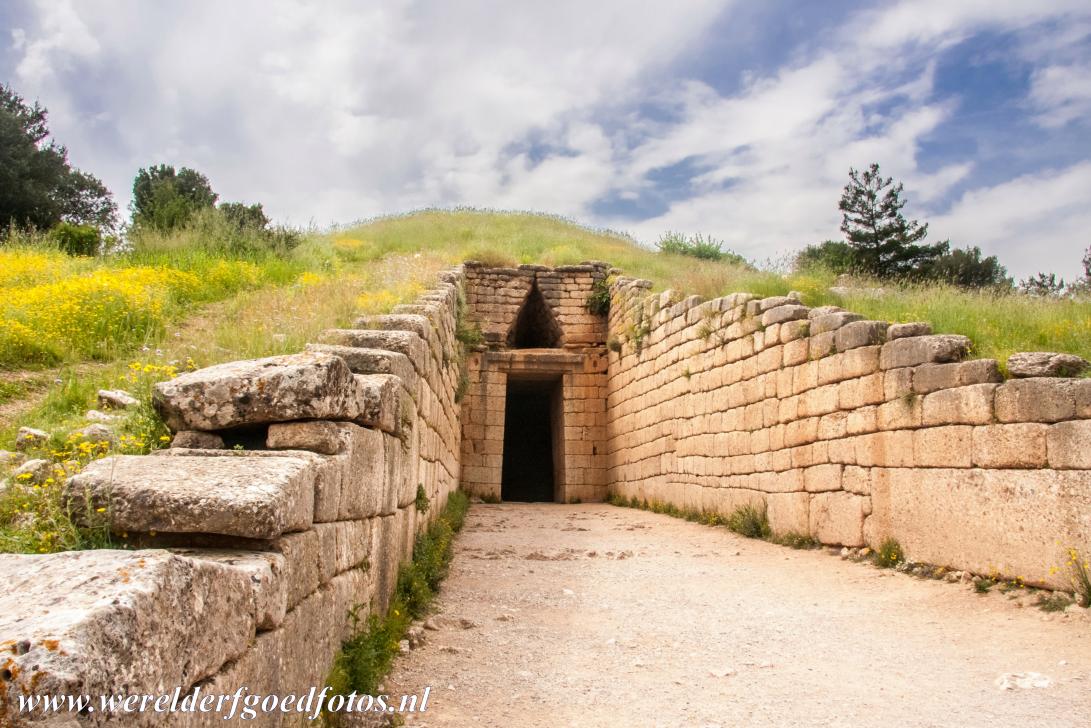
Archaeological Site of Mycenae: The Treasury of Atreus on Panagitsa Hill at the ancient city of Mycenae dates from about the 14th century BC. A 36 metres long path leads to the entrance of the beehive shaped tomb. Above the entrance is a triangle air intake. The Treasury of Atreus is 13.5 metres high and has a diameter of 14.5 metres. The lintel stone above the doorway weighs about 120 tons. The Treasury of Atreus is also known as the Tomb of Agamemnon.

Archaeological Site of Mycenae: The Treasury of Atreus on Panagitsa Hill at the ancient city of Mycenae dates from about the 14th century BC. A 36 metres long path leads to the entrance of the beehive shaped tomb. Above the entrance is a triangle air intake. The Treasury of Atreus is 13.5 metres high and has a diameter of 14.5 metres. The lintel stone above the doorway weighs about 120 tons. The Treasury of Atreus is also known as the Tomb of Agamemnon.
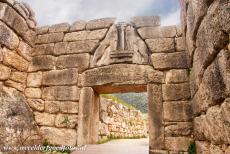
Archaeological Site of Mycenae: The Lion Gate was the main entrance to the fortified citadel of Mycenae. The huge gate was already excavated and restored in 1841 by a Greek archaeologist. The German amateur archaeologist Heinrich Schliemann started the complete excavations at Mycenae In 1874, he hoped to find the grave of Agamemnon, the legendary king of Mycenae. Mycenae had at least two entrances, the famous Lion Gate and North Gate, a secondary gate.
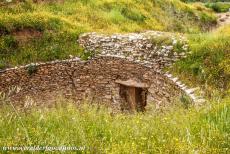
Archaeological Site of Mycenae: The roof of the tholos tomb of Aegisthus collapsed a long time ago. The tholos tomb of Aegisthus (or Aigisthos) is one of the earliest tombs of Mycenae, it was built in the 15th century BC outside the walls of Mycenae. Nine royal tombs were built around Mycenae in the 15th and 14th centuries BC. The most imposing are the Treasury of Atreus and the Tomb of Clytemnestra. The Archaeological Site of Mycenae is a UNESCO World Heritage.
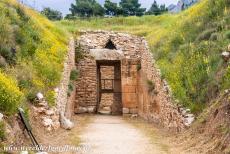
Archaeological Site of Mycenae: The remains of the tholos tomb of Aegisthus, the tholos tomb is dated from around 1470 BC. Aegisthus, also known as Aigisthos, was the lover of Clytemnestra, Queen Consort of Agamemnon. Agamemnon was the king of Mycenae and the commander of the Greek army in the Trojan War. The tholoi were the imposing burial vaults for the upper class of Mycenae. The tholoi are situated outside the citadel of Mycenae.
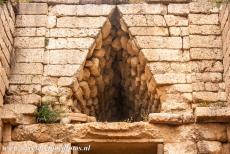
Archaeological Site of Mycenae: Air intake above the entrance of the Tomb of Clytemnestra. The Tomb of Clytemnestra is one of the later tholos tombs of Mycenae, the tholos was built between 1300 and 1220 BC. Clytemnestra was the Queen Consort of Agamemnon, the king of Mycenae. Although known as the tomb of Clytemnestra, archaeologists are not sure if this is the real tomb of Queen Clytemnestra, it is believed so because of the golden jewelry found inside the tomb.
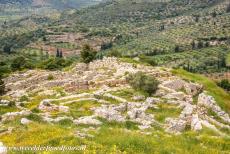
Archaeological Site of Mycenae: View of the lower city from the citadel of Mycenae. Mycenae is situated on the Peloponnese peninsula in Greece, situated on the top of a hill overlooking the fertile plains of Argolis. The remains of Mycenae are surrounded by olive groves. Olive oil was an important product during the Mycenaean period, the Greek poet Homer referred to olive oil as 'liquid gold'. Heinrich Schliemann undertook the excavations at Mycenae in 1874.
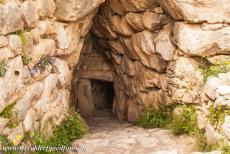
Archaeological Site of Mycenae: The secret passage to an underground cistern, the entrance has a typical triangular shape. A steep stairway leads down to a small basin which was supplied with fresh water from the Perseia Spring, it was was named after the legendary founder of Mycenae, King Perseus. While under siege, the citadel of Mycenae had its own fresh water supply, this was very important to survive. The cistern is situated close to the North Gate.
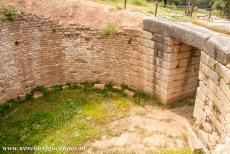
Archaeological Site of Mycenae: The roof of this tholos collapsed ages ago. Mycenaeans buried their deceased nobles in large beehive-shaped tombs, called tholos tombs. Tholos tombs were huge circular stone structures with a conical roof. After the first excavations in Troy in 1870, the German adventurer Schliemann started excavations at Mycenae in 1874, he hoped to find the grave of Agamemnon, the legendary king of Homer's great epic poems the Iliad and Odyssey.
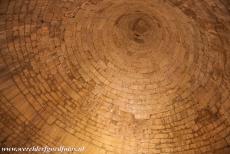
Archaeological Site of Mycenae: The interior of the impressive tomb of the Treasury of Atreus. The Treasury of Atreus is a tholos tomb, a circular beehive-shaped structure built of stones, the top of the tholos was closed with a single stone. The huge structure was covered by a thick layer of earth. The tholos tomb was built without the use of mortar. Archaeological Mycenae is part of the UNESCO World Heritage Site: Archaeological Sites of Mycenae and Tiryns.
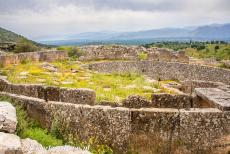
Archaeological Site of Mycenae: The walled enclosure contains six shaft graves, where nineteen bodies were buried. The shaft graves were excavated by Heinrich Schliemann in 1876. Among the found objects were gold death masks, one of the masks became known as the 'Death Mask of Agamemnon', it adorned one of the bodies in the shaft graves. The mask is one of the most famous artifacts from the Greek Bronze Age,Mycenae dates from 1700 BC to 1100 BC.
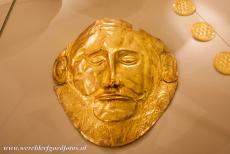
Archaeological Site of Mycenae: The gold 'Death Mask of Agamemnon', King of Mycenae, is one of the great artifacts from the Greek Bronze Age. The original mask is on display in the National Archaeological Museum Athens, a replica is on display at the Archaeological Museum of Ancient Mycenae. The museum houses several artifacts that were found during the excavations at the Archaeological Site of Mycenae. The poet Homer described the city as: 'Mycenae, rich in gold'.
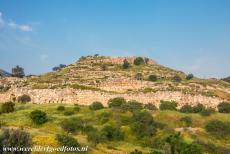
Mycenae dominated the Peloponnese, a peninsula in southern Greece. The citadel of Mycenae was a military stronghold. Just like Tiryns, the citadel was surrounded by a cyclopean wall made of huge limestone boulders, the ancient Greeks believed that the wall was made by Cyclops, the cyclopean walls were most characteristic for the Mycenaean architecture. Only the upper class inhabited the citadel of Mycenae, the ordinary people lived outside the cyclopean wall.
